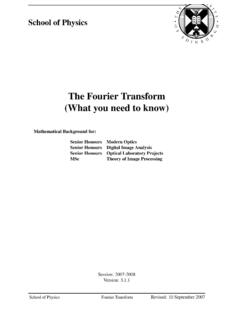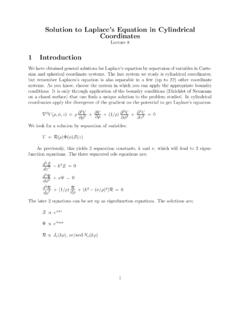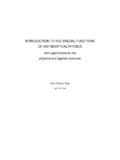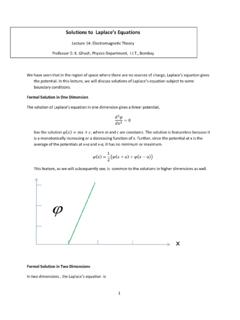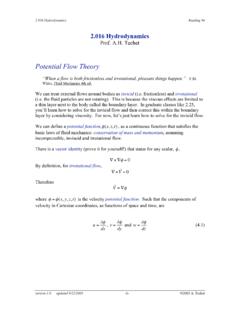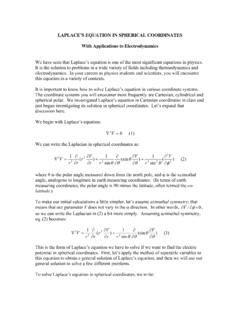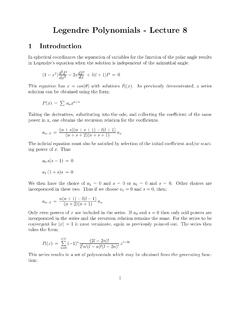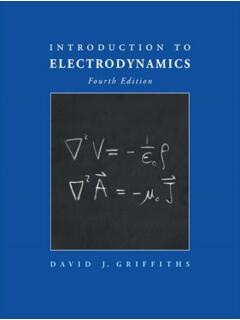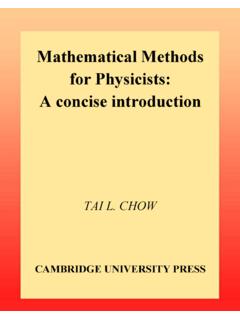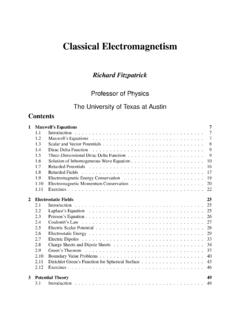Transcription of 6 Wave equation in spherical polar coordinates
1 6 Wave equation in spherical polar coordinatesWe now look at solving problems involving the Laplacian in spherical polar coordinates . The angulardependence of the solutions will be described byspherical take the wave equation as a special case: 2u=1c2 2u t2 The Laplacian given by Eqn. ( ) can be rewritten as: 2u= 2u r2+2r u r radial part+1r2sin (sin u )+1r2sin2 2u 2 angular part.( ) Separating the variablesWe consider solutions of separated formu(r, , , t)=R(r) ( ) ( )T(t).Substitute this into the wave equation and divide across byu=R T:1Rd2 Rdr2+2rRdRdr+1r21 sin dd (sin d d )+1r2sin2 1 d2 d 2= First separation:r, , versustLHS(r, , ) = RHS(t) = constant = gives theTequation:1c21Td2 Tdt2= k2( )which is easy to Second separation: , versusrMultiply LHS equation byr2and rearrange: 1 sin dd (sin d d ) 1sin2 1 d2 d 2=r2Rd2 Rdr2+2rRdRdr+k2r2.
2 ( )LHS( , ) = RHS(r) = constant = We choose the separation constant to be . For later convenience, it will turn out that =l(l+ 1)wherelhas to be the RHS equation byR/r2gives theRequation:d2 Rdr2+2rdRdr+[k2 r2]R=0.( )This can be turned into Bessel s equation ; we ll do this Third separation: versus Multiply LHS of Eqn. ( ) by sin2 and rearrange:sin dd (sin d d )+ sin2 = 1 d2 d 2=m2 LHS( ) = RHS( ) = constant = RHS equation gives the equation without rearrangement:d2 d 2= m2 .( )Multiply the LHS by /sin2 to get the equation :1sin dd (sin d d )+[ m2sin2 ] = 0.( ) Solving the separated equationsNow we need to solve the ODEs that we got from the original PDE by separating Solving theTequationEqn.
3 ( ) is of simple harmonic form and solved as before, giving sinusoids as solutions:d2 Tdt2= c2k2T 2kT,with k= Solving the equationEqn. ( ) is easily solved. Rather than using cos and sin, it is more convenient to use complexexponentials: ( )=e im Note that we have to include both positive and negative values is an angular coordinate, we expect our solutions to besingle-valued, unchanged as we goright round the circle +2 : ( +2 ) = ( ) ei2 m=1 m= is another example of a BC (periodic in this case) quantising a separation principlemcan take any integer value between and .It turns out in Quantum Mechanics thatmis the integer magnetic quantum number and l m lfor thez-component of angular momentum.
4 In that context we will see that it is restricted to therange l m Solving the equationStarting from Eqn. ( ), make a change of variablesw= cos :ddw=d dwdd =(dwd ) 1dd = 1sin dd ,(1 w2)ddw= 1 cos2 sin dd = sin2 sin dd = sin dd ,ddw(1 w2)ddw= 1sin dd [ sin dd ]=1sin dd [sin dd ].Eqn. ( ) becomes(ddw(1 w2)ddw+ m21 w2) (w) = is known as theAssociated Legendre equation . Solutions of the Associated Legendre Equationare the Associated Legendre Polynomials. Note that the equation depends onm2and the equationand solutions are the same for +mand will turn out that there are smart ways to generate solutions form(= 0 from the solutions form= 0 using angular momentum ladder operators (see quantum mechanics of hydrogen atom).)
5 Soit would be unnecessarily heroic to directly solve this equation form(= this course we will only solve this equation form= Solving the Legendre equationForm= 0 we can write the special case as theLegendre equation :((1 w2)d2dw2 2wddw+ ) (w) = apply the method of Froebenius by taking (w)= i=0ciwiThen i=0cii(i 1)(wi 2 wi) 2ciiwi+ ciwi=0and rearranging the series to always refer the powerwi, i=0[ci+2(i+ 2)(i+ 1) +ci( i(i 1) 2i]wi=0 Since this is true for allw, it is true term by term, and the indicial equation isci+2((i+ 2)(i+ 1)) =ci(i(i+ 1) )Start The series switches on whenc0 0 = 0 admitsc0(= 0 andc 2=0 Also whenc1 0 = 0 admitsc1(= 0 andc 1= Note, howeverci+2*cifor largei.))))
6 This gives an ill convergent series and for finite solutionsthe series must terminate at some value of i, which we calll. Thus, =l(l+ 1)for some (quantised) integer will turn out in quantum mechanics thatlis the orbital angular momentum quantum Legendre polynomialsWe denote the solutions the Legendre polynomialsPl(w) Pl(cos )For example:P0starts, and terminates with a single , and terminates with a single , withC0and terminates first few areP0(w)=1P1(w)=wP2(w)=12(3w2 1)P3(w)=12(5w3 3w)Exercise:use the recurrence relationci+2((i+ 2)(i+ 1)) =ci(i(i+ 1) l(l+ 1))to verify that these are our series solutions of Legendre s OrgthogonalityThe orthogonality relation is 1 1Pm(w)Pn(w)dw= 0Pm(cos )Pn(cos ) sin d =Nm mnwhereNmis a normalisation factor that we do not need quantum mechanics this is already sufficient to cover S, P , D and F Associated Legendre polynomialsAs mentioned the associated Legendre polynomials can be produced from Legendre polynomials inquantum mechanics using angular momentum ladder operators.
7 Firstly,P0l(w)=Pl(w)47 Without proof, we can note that it can be shown that ifPl(w) satisfies Legendre s equation , thenP|m|l(w) = (1 w2)|m|/2d|m|dw|m|Pl(w)will satisfy the associated Legendre polynomial for magnetic quantum a polynomial of orderl, then the abovem-th derivative vanishes for|m|>land thusm= l, l+1, .. ,0, .. l 1, General angular solutionPutting aside the radial part for the moment, the rest of the general solution is: ( ) ( )T(t)= l=0l m= lPml(cos )eim (Emlcos kt+Fmlsin kt)The angular dependence is given by the combination:Pml(cos )eim Ylm( , )These are known as thespherical harmonics(once we include a normalisation constant). We lldiscuss these more in Sec.
8 What we have not yet established is the link between the value ofk(and hence k) and the values ofmandl. To do this, we would need to solve the radial equationfor various special The spherical harmonicsSpherical harmonics{Yml( , )}provide a complete, orthonormal basis for expanding the angulardependence of a function. They crop up a lot in physics because they are the normal mode solutionsto the angular part of the Laplacian. They are defined as:Yml( , )=( 1)m 2 2l+12 (l m)!(l+m)!Pml(cos )eim .The extra factor of ( 1)mintroduced is just a convention and does not affect the orthonormalityof the spherical harmonics satisfy an orthogonality relation: 2 0d 0d sin [Ym1l1( , )] Ym2l2( , )= l1,l2 m1, that they are orthonormal, not just orthogonal, as the constant multiplying the product ofKronecker deltas is Completeness and the Laplace expansionThe completeness property means that any functionf( , ) evaluated over the surface of the unitsphere can be expanded in the double series known as theLaplace series:f( , )= l=0l m= lalmYml( , ), alm= 0d d sin [Yml( , )] f( , ).
9 Note that the sum overmonly runs from ltol, because the associated Laplace polynomialsPmlare zero outside this Time independent Schroedinger equation in central potentialConsider h22m 2 (x)+ V(r) (x)= E (x).We consider solutions of separated form: (r, , )=R(r) ( ) ( ). Substitute into Schroedingerequation and divide across by =R .2m h2(V(r) E) 1R1r2 rr2 rR=1 1r2sin sin +1 1r2sin2 2 2 Multiplying through byr2r22m h2(V(r) E) 1R rr2 rR=1 1sin sin +1 1sin2 2 2 First separation: radial & angular dependenceLHS(r) = RHS( , ) = constant = l(l+ 1). Radial equation [ rr2 r+l(l+ 1) +r22m h2(V(r) E)]R=0 The differential equation is simplified by a substitution,u(r)=rR(r)u (r)=R(r)+rR (r)u (r)=2R (r)+rR (r)=1r rr2 rRand so[ d2dr2+l(l+ 1)r2+2m h2(V(r) E)]u(r) = 0We take a Coulomb potential and will be considering bound states, withE<0.
10 It is convenient torewrite in terms of the modulus|E|and introduce explicit negative sign. We also change variablesto = 8m|E| hrV(r)= e24 *0r= e2 8m|E|4 *0 h ,and so multiplying by1rand expressing in terms ofu{8m|E| h2[ d2d 2+l(l+ 1) 2]+2m h2[|E| e24 *0 8m|E| h2]}u( ) = 0We define =e24 #0 h m2|E|= mc22|E|, where =e24 #0 hc*1137is the fine structure constant. Thisgives us[d2d 2 14 l(l+ 1) 2+ ]u( ) = Solution by method of FroebeniusWe are now (almost!) ready to apply the method of Froebenius. In principle it could immediatelybe applied and we would get a an infinite Taylor series that indeed solves the , a closed form solution can be obtained with one extra transformation that removes anover all exponential dependence on.







